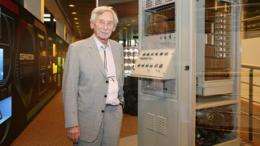A pioneering computer found in the basement of EPFL

On Wednesday, on the occasion of the launch of its new exhibitions, the Bolo Museum has unveiled the CORA 1, a computer developed to serve the needs of the Swiss army at the end of the 1950s. Peter Toth, its designer, was at EPFL to talk about his adventure.
Computers have become so much part of our environment that they now tend to … disappear! Miniaturized and multiplied, processors are now hidden in most of the objects we encounter in everyday life. As a result, there are now very few requirements for large, centralizing machines.
This observation was the starting point for the development of the new exhibition of the Mémoires Informatiques Foundation, located at EPFL and whose "treasure" is made up of over one thousand computers, as well as numerous books and software products. “Scheduled disappearance” takes the form of a vast network of questions and answers, clues, suspects and culprits, which bring to light some of the most remarkable elements of the exhibition. “We imagined the presentation as a kind of mind map where the visitors themselves are encouraged to conduct the enquiry into this disappearance”, explains Yves Bolognini, the president of the Foundation with responsibility for the museum.
One of the first digital machines
Among them, Yves Bolognini brought out from a basement at EPFL an exceptional machine. “I had to conduct a real enquiry to find the origin of this computer”, he relates. Called CORA 1, it was developed for applications related to defence against aviation by a Hungarian-born engineer called Peter Toth, who now lives in Zurich, and who on Wednesday was there at the presentation of “his” machine at the Bolo Museum.

Just as an anecdote, CORA was presented to the public during Expo 64 in Lausanne. It was controlling the pencil, which on a large work table was reproducing, among others, the outlines of Thoune castle. “However, we had taken the trouble to conceal the computer behind a wall in order not to frighten the visitors, still very wary of these machines”, recalls Peter Toth today.
A reflexion on society
The task of creating the newset for the Bolo museum was assigned to Oxyde, the Lausanne design studio. While examining this wall, going from one clue to the next, the visitor not only witnesses the evolution of the machines, but also the more and more symbiotic relationships that human beings have with them. “We wanted to present more than a mere technological exhibition”, adds Yves Bolognini. “Computing has become so important in our societies that it seems necessary to step back a little and take stock, to understand how we got here and to imagine how it will continue to evolve.”
Provided by Ecole Polytechnique Federale de Lausanne



















